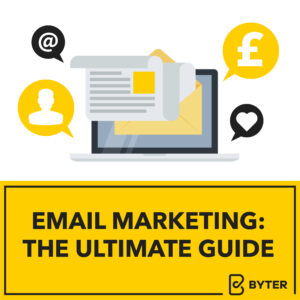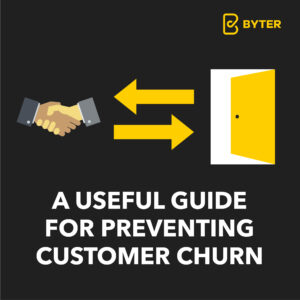Email Marketing: The Ultimate Guide
Did you know there are over 4 billion email users worldwide? That’s more than half the world’s population and shows that email marketing is an opportunity your business can’t afford to miss out on. Whether you’re a small business with limited resources or a large business with an enormous budget, email marketing is a strategy that anyone can master and benefit from. Keep reading for the full email marketing guide.
In recent years social media has become the digital marketing tool that everyone’s talking about, and email marketing is often looked at as a thing of the past. However, email marketing is still up there as one of the best. In fact, according to a study done by McKinsey & Company, Email marketing can be up to 40 times more effective than social media. The key to this success is ensuring your email marketing meets the following three necessary elements:
- You do not bombard your recipients with emails.
- Your emails contain high-quality content that meets the interests of your recipients.
- You include a compelling CTA, (call to action).
What is email marketing?
Before we show you how to conduct the perfect email marketing campaign, let’s start with a definition of what it is.
Email marketing is a digital marketing method that uses email to promote products or services and encourages brand loyalty. Email marketing aims to build customer relationships and keep customers engaged between purchases. In it’s simplest form email marketing is a type of advertisement.
So now we’ve covered the ‘whats’ let’s cover the ‘hows’… here are our four steps explaining how you can build the perfect email marketing campaign.
Step 1. Plan your email marketing strategy
Planning is an essential part of building your campaign. Your emails are at high risk of becoming lost in overcrowded inboxes or getting sent straight to spam. That’s why it’s crucial that you strategise your approach. Here’s a little roadmap of how to do it:
-
Define your audience
Just like every other marketing strategy, you must begin by creating your buyer persona. Who will you be sending your emails to? What are their needs and pain points? This is who you will tailor your email content to.
-
Set your goals
Motivation comes from having something to work towards, so research email statistics for your industry and set yourself some realistic benchmarks.
-
Choose your Email campaign type
There are lots of different types of email campaigns that suit different industries and recipient demographics. For example, standard promotional campaigns, newsletters, product announcements, abandoned carts, and more. Decide which campaign is best for your audience.
-
Create a campaign schedule
The best way to stay organised and make sure your campaign doesn’t lose momentum is to stick to a schedule. When deciding how often your emails will go out, first consider how often is too often? i.e. don’t bombard your recipients, and secondly, think about what is the right length of time to leave between emails to ensure your recipients don’t forget about you.
Step 2. Build your email list
Once you’ve finished planning your campaign you can start putting it together. Start by building an email list of eager prospects that are interested in hearing from you. Wondering how to do that? We’ve got you covered.
There are two elements to building a healthy email list, the first involves using lead magnets to lure in potential customers, the second involves producing compelling opt-in forms. Let’s take a look at these in more detail…
Lead Magnets
If you want to generate an authentic list of emails from people who are actually interested in what your business has to offer, then using lead magnets is a great method for naturally attracting these prospects. A lead magnet is essentially a piece of content, related to your industry, that you offer to people for free in exchange for their email address. Examples of lead magnets are:
- Ebook
- Whitepaper
- Infographic
- Template
- Webinar
- Software or tool
Lead magnets are effective for two reasons. Firstly, because lead magnets are related to and relevant to your business, they attract the right kind of prospects who fit your buyer persona and secondly, because they actually work, people tend to be willing to hand over their email addresses if they’re going to receive something of value to them in return.
Opt-in forms
You’ve created an attractive lead magnet, and it’s drawing interest from potential customers. What next? This is where an opt-in form comes in. Not having one is the only thing stopping your future leads from accessing the incredible asset you’ve designed for them and stopping you from securing their email addresses.
What is an opt-in form you ask? It’s a digital form containing a few simple fields to be filled in by your prospects. Once the form is completed, your potential customers will be granted access to your lead magnet, and you will receive the information they entered.
Here are three things to remember when creating your opt-in form:
- Keep it simple
A lengthy form with too much copy and an excessive number of fields to complete will deter your future leads. Only ask for basic information and keep it to the point.
- Make sure it’s attractive
Your opt-in form is the first thing people see so the design work needs to be tip-top. Consider adding an attention-grabbing header that will excite people and persuade them to sign up.
- Only add relevant info
Your primary goal is to get people to sign up, but don’t do this by embellishing or through deception. Make sure all the information on your form is relevant and an accurate description of what they will receive.
Step 3. Send your emails
After all the time and effort that went into building the perfect email list, wouldn’t it be a shame if your email is sent straight to spam? Well, that’s exactly what will happen if you lose momentum now. Before you send your email, there’s a little more hard work to be done. Don’t worry though, it will pay off. Here are the next things you need to do:
Choose an email marketing service provider
Since you’re going to be sending out a lot of emails, it’s only wise to choose an email marketing service to support you in your marketing efforts. These are simply tools or software that allow you to design and personalise professional-looking emails which can then be scheduled and sent en-masse. They also offer a breakdown of the data so you can analyse your efforts.
Segment your email list
Your current email list can be segmented into categories which will allow you to send more targeted emails. For example, you may want to segment your list according to age-groups, interests or preferences. This will help you to be more personal with your campaign, instead of sending out generic emails containing ‘canned’ copy.
Craft your email
You might know what the content of your email is going to be, but do you know how to optimise every inch of it to make sure it lands perfectly? Here are our top tips for crafting the perfect marketing email:
- Write relevant and consistent copy
Try and stick to one topic in your email so that there’s a clear, defined point that your CTA will follow naturally from. Also, decide on a TOV (tone of voice) that will be iconic to all of your brand’s copy, and be consistent with it throughout your emails.
- Include high-quality images
How do you make an email look nice? By including high-quality, attractive images that will make it more interesting and break up the text. Make sure they’re relevant to your topic.
- Add a CTA
A CTA, or “call to action” is a word or phrase that prompts a response from the reader. For example, if the aim of your email is to direct the reader to your website, tell them to click on a link to it.
- Consider the time of day
The best time of day to send a marketing email is between 8:00 am and 9:00 am. During this time your email has the highest chance of being opened.
- Insert an enticing subject line
The first thing your recipients will see is the subject line, think of this as your elevator pitch. In less than 150 characters you need to convince them to open your email. Be clear, concise and use enticing language.
If you’d like to see these tips in more detail, we’ve dedicated an article to just that. Don’t say we never treat you. Read it here.
Now you’ve crafted the perfect email, you should be ready to click send. Once your email has been delivered, the waiting game begins. However, your work isn’t over yet. Next up is email marketing analysis…
Step 4. Analyse your email marketing
Measuring the effectiveness of your marketing campaign is going to equip you to make better decisions in the future that will help you to cater for your readers and subscribers and ultimately have a positive impact on your business. Here are four key metrics you should pay attention to when measuring the effectiveness of your campaign:
Deliverability
The rate at which your email reaches the intended recipient’s inboxes.
Open rate
The percentage of recipients that open the email.
Clickthrough rate
The percentage of recipients that click on the CTA.
Unsubscribers
The number of people who, since receiving your email, have opted out of your email list.
A/B testing
It can be hard to tell which aspects of your email campaigns are hitting a high note with your audience and which aspects are falling short. That’s where A/B testing comes to the rescue. Here’s how to do it:
- Choose a variable to test, e.g. CTA, images, subject line.
- Create two versions of the same email, one containing the variable and one without it.
- Simultaneously send each email, one email should go to half of your email list and the other should go to the second half of your email list.
- Now you can measure the effectiveness of the chosen variable by seeing which email performed better.
This article was a long one, we know. But we wanted to treat you to a comprehensive guide so you can make better-informed decisions when crafting your next email marketing campaign. Good luck!
As Always, Good Luck!










